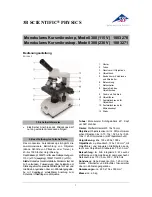
5
NUMERICAL APERTURE (NA)
– a measure of an objective’s light gathering
capabilities. The concept may be compared to the F-valve in
photographic lenses. Generally speaking, objectives with N.A. values of
less than 1.00 are "Dry" objectives. Values of 1.00 or greater require oil as
a medium. Please note that condensers are part of the optical system and
are also assigned an N.A. value. That value must be at least as high as
that of the highest objective used.
PARFOCAL -
A term applied to objectives and eyepieces when practically
no change in focus has to be made when an objective of one power is
substituted for another. The DIN objectives on your Swift M3500 Series
Microscope are parfocaled at the factory to a standard 45mm distance,
so that only a slight turn of the fine adjustment is required when a
change is made from a lower to higher power.
RESOLVING POWER -
The ability of a lens to clearly separate fine detail.
Resolving power is directly proportional to the numerical aperture of the
optical system.
WORKING DISTANCE
– the distance from the lens of the objective to the
cover slip on the slide, when the specimen is in focus.
USING YOUR SWIFT
M3500 MICROSCOPE
1. Use the stage clips or slide holder mechanism to secure the slide in
place. Be sure the specimen is centered over the opening in the
stage.
2. Rotate the nosepiece to place the lowest power (4X) objective over
the specimen. Be sure the objective “clicks” into position.
The disc or iris diaphragm should be turned or adjusted to the largest
aperture, allowing the built-in substage illuminator to provide a
constant, even dispersion of light to the optical system. The disc or
iris diaphragm is not intended to control the brightness of the
illumination. The purpose of the diaphragm is to match the
numerical aperture of the objective. Smaller apertures increase
contrast in the image while large apertures decrease the contrast. A
good procedure in selecting the proper aperture is to start with the
largest and reduce until the fine detail of the specimen is in exact
focus.
Содержание M3500 SERIES
Страница 13: ......




























